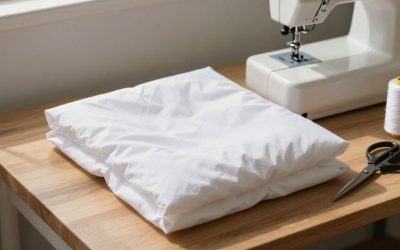When it comes to choosing the ideal pillow for your sleeping comfort needs, two of the most popular choices are microfiber and polyester pillows. With both types of pillows offering plenty of advantages, it’s important to understand the benefits and drawbacks of each in order to determine which is the best fit for your particular needs. This article provides an overview and comparison of microfiber and polyester pillows, as well as factors to consider when choosing between the two.
Benefits and Drawbacks of Microfiber Pillows
Microfiber pillows offer several advantages, such as a lightweight and gentle feel. Their dense fibers contour to the body, providing optimal support throughout the night. Despite their thickness, they tend to be less bulky than traditional pillows, making them ideal for anyone seeking a fluffier sleeping experience without the bulkiness that some other types of pillows can provide. In addition, microfiber pillows are also hypoallergenic and naturally resistant to bacteria, mold, and dust mites. As such, they’re ideal for those with allergies or asthma.
One of the primary drawbacks of microfiber pillows is that they do not tend to recover their shape or bounce back as easily as other types of pillows. This can lead to premature flattening and a less-than-optimal sleeping experience. In addition, due to their dense fibers, they do not breathe as well as other types of pillows, so they can get hot and stuffy during the night.
On the plus side, microfiber pillows are generally more affordable than other types of pillows, making them a great option for those on a budget. They are also easy to clean and maintain, as they can be machine washed and dried. Finally, they are available in a variety of sizes and shapes, so you can find one that fits your individual needs.
Overall, microfiber pillows offer a great combination of comfort and support, but they may not be the best choice for everyone. If you’re looking for a pillow that will last for years and provide superior breathability, you may want to consider other types of pillows. However, if you’re looking for a lightweight, hypoallergenic pillow that won’t break the bank, microfiber pillows are definitely worth considering.
Benefits and Drawbacks of Polyester Pillows
Polyester pillows are renowned for their durability and resilience. They tend to maintain their shape for much longer than other types of pillows, so they can deliver comfort and support night after night. In addition, polyester also has breathability since the material is made up of individual strands that help air circulate throughout the pillow. This helps keep users cool throughout the night.
One of the main drawbacks of polyester pillows is that they often have an overly-firm feel due to their resilience. This may not be ideal for those who are seeking a soft and comforting sleeping experience. In addition, polyester pillows tend to be heavier than microfiber options, so they may feel cumbersome if you’re often shifting or rearranging while sleeping.
Polyester pillows are also not as absorbent as other materials, so they may not be the best choice for those who suffer from night sweats. Furthermore, polyester pillows are not as environmentally friendly as other materials, as they are made from synthetic fibers. This means that they are not biodegradable and can take a long time to break down.
Comparative Advantages of Each Type of Pillow
When comparing the two types of pillows side-by-side, it’s important to consider their respective advantages:
- Microfiber: lightweight, gentle feel; dense fibers contour to body; hypoallergenic; bacteria, mold, and dust mite resistant.
- Polyester: durable and resilient; maintains shape longer; breathable; provides cooling comfort.
In addition to the advantages listed above, microfiber pillows are also machine washable, making them easy to clean and maintain. Polyester pillows, on the other hand, are usually dry-clean only, which can be more expensive and time-consuming.
Factors to Consider When Choosing Between Microfiber and Polyester Pillows
When choosing between microfiber and polyester pillows, it’s important to assess your own needs and preferences. If you’re looking for a softer pillow with a gentle feel, then a microfiber option may be best-suited for your needs. However, if you’re in search of a more durable pillow that can provide long-lasting comfort and support night after night, then polyester may be the right fit.
In addition to comfort and durability, it’s also important to consider the cost of the pillow. Microfiber pillows tend to be more affordable than polyester pillows, making them a great option for those on a budget. However, if you’re willing to invest in a higher-quality pillow, then a polyester option may be the better choice.
Finally, it’s important to consider the environmental impact of the pillow you choose. Microfiber pillows are often made from recycled materials, making them a more sustainable option than polyester pillows. However, polyester pillows are often more durable and can last longer, reducing the need for frequent replacements.
Maintenance Considerations for Microfiber and Polyester Pillows
Whether you opt for a microfiber or polyester pillow, it’s important to note that all types of pillows require regular maintenance to prolong their lifespan. To ensure your pillows remain clean and free from any dirt and debris, be sure to fluff, shake out, and air out your pillow on a regular basis. Microfiber pillows should be washed with detergent for best results; however, washing polyester pillows can cause them to become lumpy and unshapely. Here, spot-cleaning is often the best option.
When spot-cleaning polyester pillows, it is important to use a mild detergent and warm water. Be sure to avoid using any harsh chemicals or abrasive scrubbing tools, as these can damage the fabric. Additionally, it is important to avoid using hot water, as this can cause the fabric to shrink. After spot-cleaning, be sure to rinse the pillow thoroughly and allow it to air dry completely before using it again.
In addition to regular cleaning, it is important to rotate your pillows on a regular basis. This will help to ensure that the pillows maintain their shape and provide even support for your head and neck. Additionally, it is important to replace your pillows every two to three years, as this will help to ensure that you are getting the best possible support and comfort from your pillows.
Cost Comparison of Microfiber and Polyester Pillows
Though cost can still vary based on brand, style, size and quality, it’s generally accepted that polyester pillows are more affordable than their microfiber counterparts due to their higher-grade materials. As such, polyester is often best-suited for those seeking an economical option without compromising on quality.
Microfiber pillows, on the other hand, are typically more expensive due to their superior construction and materials. They are often made with a combination of polyester and rayon, which is a more expensive fabric than polyester alone. Additionally, microfiber pillows are often filled with a higher-grade foam or down alternative, which can also add to the cost.
When it comes to cost, it’s important to consider the long-term value of the pillow. While polyester pillows may be more affordable upfront, they may not last as long as their microfiber counterparts. Microfiber pillows are often more durable and can last for years with proper care, making them a better value in the long run.
Summary: Which Type of Pillow is Right for You?
Ultimately, the type of pillow you choose comes down to personal preference. Both microfiber and polyester pillows offer their own benefits and drawbacks, so consider your own needs and sleeping habits when making your decision.
Microfiber pillows are often softer and more comfortable than polyester pillows, but they may not provide the same level of support. Polyester pillows are usually firmer and more supportive, but they may not be as comfortable as microfiber pillows. Additionally, microfiber pillows are usually more affordable than polyester pillows.



